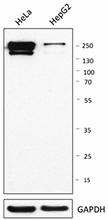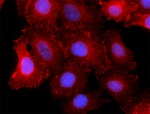- Clone
- O92G9 (See other available formats)
- Regulatory Status
- RUO
- Other Names
- L1CAM, Neural cell adhesion molecule L1, NCAM-L1
- Isotype
- Mouse IgG1, κ
- Ave. Rating
- Submit a Review
- Product Citations
- publications

-

Total cell lysate (12 µg protein) from HeLa and HepG2 cells were resolved by electrophoresis, transferred to nitrocellulose, and probed with purified anti-CD171 (clone O92G9) antibody. Proteins were visualized using an HRP goat anti-mouse-IgG secondary antibody and chemiluminescence detection. -

HeLa cells were fixed with 2% paraformaldehyde (PFA) for 15 minutes, permeabilized with 0.5% Triton X-100 for three minutes, and blocked with 5% FBS for 60 minutes. Then the cells were intracellularly stained with 2.5 µg/ml anti-CD171 (clone O92G9) antibody overnight at 4°C followed by Alexa Fluor® 594 (red) conjugated goat anti-mouse IgG for one hour at room temperature. Nuclei were counterstained with DAPI (blue). The image was captured with a 60X objective.
| Cat # | Size | Price | Quantity Check Availability | Save | ||
|---|---|---|---|---|---|---|
| 686102 | 100 µg | 221€ | ||||
L1CAM is a 200–220 kD transmembrane glycoprotein of the immunoglobulin (Ig) superfamily. It is composed of 6 Ig-like domains and 5 fibronectin type III repeats followed by a transmembrane region and a highly conserved cytoplasmic tail. The members of the L1 family are L1-CAM (CD171), close homolog of L1-CAM (CHL1), neurofascin (NFASC) and NgCAM related cell adhesion molecule (NR-CAM). L1CAM can bind to itself (homophilic) or heterophilically to other neural cell adhesion molecules, integrins, CD24, neurocan and neuropilin-1. The cytoplasmic tail of L1CAM can interact with the cytoskeletal proteins ankyrin, actin, spectrin and ERM proteins. L1CAM was discovered as a cell adhesion molecule in the nervous system. During brain development, L1CAM is involved in neurite outgrowth and fasciculation, as well as adhesion and migration. In addition, L1CAM participates in myelination processes by mediating the elongation of Schwann cells along the axon and promotes neural cell survival. Mutations of the L1CAM gene cause severe recessive cerebral disorders like X-linked mental retardation and schizophrenia and frequently lead to neonatal death. L1CAM is overexpressed in many human cancers, such as ovarian and endometrial carcinoma, pancreatic cancer, melanoma and glioblastoma. L1CAM expression is usually associated with poor prognosis, an aggressive phenotype, and advanced tumor stages. Unlike in neural cells, L1CAM in the tumor setting rarely promotes static cell-cell adhesion, but induces a motile and invasive phenotype, supporting an aggressive tumor growth, metastasis and chemoresistance.
Product DetailsProduct Details
- Verified Reactivity
- Human
- Antibody Type
- Monoclonal
- Host Species
- Mouse
- Immunogen
- Full-length recombinant human CD171 produced in 293T cells.
- Formulation
- Phosphate-buffered solution, pH 7.2, containing 0.09% sodium azide.
- Preparation
- The antibody was purified by affinity chromatography.
- Concentration
- 0.5 mg/ml
- Storage & Handling
- The antibody solution should be stored undiluted between 2°C and 8°C.
- Application
-
WB - Quality tested
ICC - Verified - Recommended Usage
-
Each lot of this antibody is quality control tested by Western blotting. For Western blotting, the suggested use of this reagent is 1.0 - 5.0 µg/ml. For immunocytochemistry, a concentration range of 1.0 - 5.0 μg/ml is recommended. It is recommended that the reagent be titrated for optimal performance for each application.
- RRID
-
AB_2616878 (BioLegend Cat. No. 686102)
Antigen Details
- Structure
- 1,257 amino acid with a predicted molecular weight of 140 kD, apparent molecular weight is 200-220 kD due to its heavy glycosylation.
- Distribution
-
Cell membrane.
- Function
- Involved in neuron-neuron adhesion, neurite fasciculation, outgrowth of neurites, etc. Binds to axonin on neurons.
- Interaction
- Neural cell adhesion molecules, integrins, CD24, neurocan and neuropilin-1, ankyrin, actin, spectrin and ERM, SHTN1, and NUMB.
- Biology Area
- Cancer Biomarkers, Cell Adhesion, Cell Biology, Neuroscience, Neuroscience Cell Markers, Synaptic Biology
- Molecular Family
- Adhesion Molecules
- Antigen References
-
1. Kiefel H, et al. 2012. Cell Adh. Migr. 6:374.
2. Moos M, et al. 1988. Nature 334:701.
3. Weidle UH, et al. 2009. Anticancer Res. 29:4919.
4. Hortsch M. 2000. Mol. Cell. Neurosci. 15:1.
5. Schachner M. 1997. Curr. Opin. Cell Biol. 9:627.
6. Jouet M, et al. 1996. J. Med. Genet. 33:248.
7. Rathjen FG, et al. 1984. EMBO J 3:1.
8. Gavert N, et al. 2008. Expert Opin. Biol. Ther. 8:1749.
9. Schäfer MK, et al. 2010. Cell Mol. Life Sci. 67:2425. - Gene ID
- 3897 View all products for this Gene ID
- UniProt
- View information about CD171 on UniProt.org
Related Pages & Pathways
Pages
Related FAQs
Other Formats
View All CD171 (L1CAM) Reagents Request Custom Conjugation| Description | Clone | Applications |
|---|---|---|
| Purified anti-CD171 (L1CAM) | O92G9 | WB,ICC |
Compare Data Across All Formats
This data display is provided for general comparisons between formats.
Your actual data may vary due to variations in samples, target cells, instruments and their settings, staining conditions, and other factors.
If you need assistance with selecting the best format contact our expert technical support team.
 Login / Register
Login / Register 









Follow Us